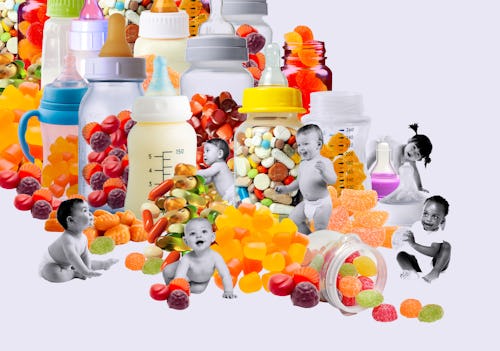
You’ve been on the neuropsych wait list for eight months. You’ve been searching for an in-network health care provider for a year. You have a feeling the babysitter is going to quit soon, and that’s going to be a whole thing. And all these worries are squeezed in among the unrelenting day-to-day stream of work, groceries, bedtimes, laundry, dinners, pickups, drop-offs, well-checks, head colds, and owies. There’s been a hiccup on your way to checking almost every box on the to-do list. Bedtime takes two hours instead of 20 minutes. Balanced meals are rejected in favor of toast. You hear from school after drop-off that your kid can’t focus. Maybe something is up, but you can’t get a diagnosis because everyone’s schedule is full, and you can’t afford it anyway.
An influencer you’ve been following — you just like her vibe, she seems to get it — holds up a colorful bottle in her latest video. She’s saying something about how much easier life is now that her kids eat this gummy. A few days later, you’re at the grocery store and you see the same cheery bottle on the rainbow wall of kids’ vitamins and supplements. Maybe it says “kids immune boost,” and you’re on the 17th cold of the school year already. Or perhaps it’s the universally enticing “calm kids,” which often features buzzy ingredients like L-theanine or ashwagandha. Or a star-spangled “kids sleep support,” laden with melatonin and passionflower. The price tag of $27.99 is kind of steep but honestly not so much in the grand scheme of things, and there’s no harm in a gummy, right? You can see the apples and granola bars your family lives on from where you stand. The bananas here are safe, the pasta here is safe — so surely these are safe too.
You may have already guessed what’s coming next: In recent years, there has been an explosion of dietary supplements marketed to and purchased by parents. In 2022, the U.S. supplements industry was valued at $50 billion and is projected to grow by 5.7% by 2030; market researchers credit a shift toward “self-directed care” as a factor in the industry’s growth. A 2020 report from the Centers for Disease Control (CDC) noted that about one third of kids aged 0 to 18 take dietary supplements.
Labels on supplements are seductive and enticing to children — visually and in terms of flavorings — by design.
While the medications on the drugstore aisle that promise to treat fever or cough or seasonal allergies are all regulated by the FDA — which dictates how ingredients are tested, the dosage that the medicines contain, as well as what claims can be made about a medication’s effectiveness — supplements are not. “People are buying this stuff for their children, and it is not regulated by the FDA,” says Dr. Cora Breuner, M.D., MPH, a professor of pediatrics at the University of Washington School of Medicine. Many of the families she works with don’t realize how little oversight there is of the supplements industry. “People assume because it is natural, it’s perfectly safe. It isn’t. What you're buying may not have what it says it has in it, nor may it ever have been studied in someone your child’s age or size.”
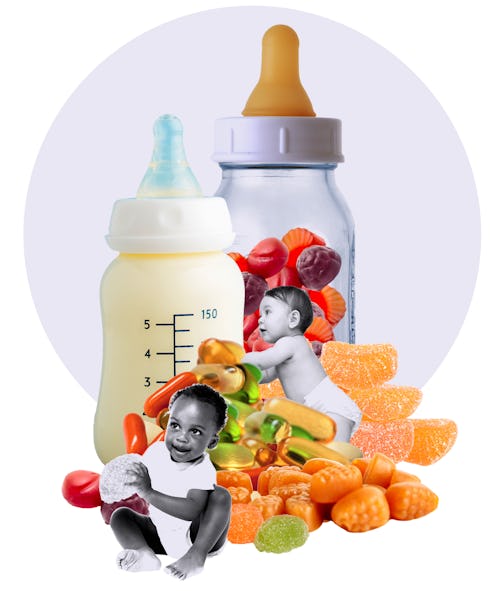
When she tells me this, it settles in and finds a home as a daily worry in me, nagging along with all the others. I — as have most of my peers — given my young child a melatonin gummy here and there. I, too, have trusted the grocery store shelves as a space I assume is vetted, supplying us with things that are healthful at best, and harmless at least.
With kindness, and perhaps a touch of seen-too-much weariness, Breuner points me to a research letter that Dr. Pieter Cohen, M.D., an associate professor of medicine at Harvard Medical School, published in The Journal of the American Medical Association in April of last year. It compared dosage claims made on melatonin supplement labels with how much melatonin was actually in each gummy. Testing 25 melatonin supplements currently on the market, Cohen and his fellow researchers found staggering discrepancies: An overwhelming majority of melatonin products contained more or less than the label promised — anywhere from 74% to 347% of the quantity claimed on the label.
Cohen’s findings point to one huge issue with the supplements industry as it stands today: a lack of quality control that many doctors understand could be dangerous. Breuner points to questions around appropriate dosages and safety standards — particularly in a pediatric population — as the driving force behind the a forthcoming policy statement she is helping to craft for the American Academy of Pediatrics (AAP) on the safety of herbs and dietary supplements in children and adolescents. (Because the statement is still in draft form, she was not able to share the exact language, but she did summarize the statement goals.)
“People assume because it is natural, it’s perfectly safe. It isn’t. What you're buying may not have what it says it has in it, nor may it ever have been studied in someone your child’s age or size.”
The policy statement, which is expected to come out in the near future pending review by the AAP and approval by its board, will call for improved regulation, quality control, and proper labeling in the herbs and dietary supplements (HDS) industry. It will also inform AAP pediatricians — many of whom, Breuner says, may not be aware themselves of how rampant supplement use is and how variable regulation is within the industry — about how to access evidence-based recommendations and counsel families on safe supplement use.
“A whole lot of people [take supplements], and it’s not just who we presume,” Breuner says. “Families of children and adolescents with complex health conditions — including those with cognitive and physical disabilities — report greater use of HDS than healthy children. It isn’t just rich white kids who use these. Kids across all ethnicities, cultures, races, and marginalized populations.” (Both Bruener and Cohen mentioned that you can look for supplements with NSF certification, a process that verifies the supplement actually contains the active ingredient advertised on the bottle and doesn’t contain undeclared ingredients. Of course, this does not mean that it’s effective for your kid or that the ingredients have been rigorously safety tested.)
To understand how we got here, we have to nerd out briefly about the history of supplement marketing regulation — or lack thereof. In 1994, Congress passed the Dietary Supplement and Health Education Act (DSHEA), which limited the FDA’s ability to provide regulatory oversight over the industry. It was a pivotal piece of legislation, explains Dr. Alan Woolf, M.D., MPH, a professor of pediatrics at Harvard Medical School and attending physician at Boston Children’s Hospital, because DSHEA created the supplements environment that we live in today. Under DSHEA, the FDA does not have the authority to approve dietary supplements before they are marketed to the public. “Ideally, you would have to prove both efficacy and safety before you market to children,” says Woolf. “There’s an assumption that there’s government intervention and regulation, and assurance of a product’s safety. After DSHEA, that’s simply not true.”
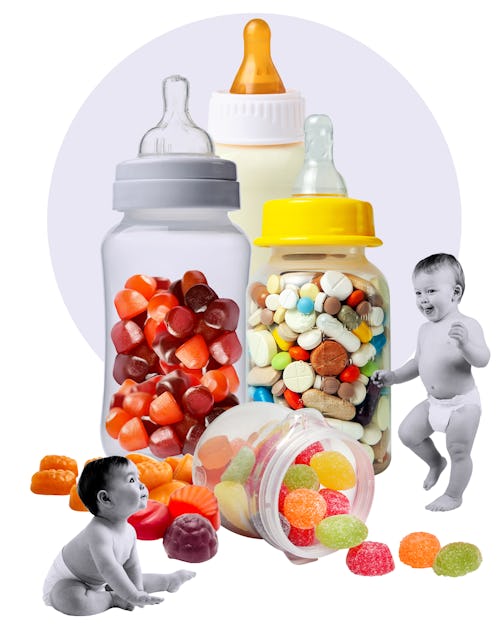
Labels on supplements are often misleading, and are, says Woolf, seductive and enticing to children — visually and in terms of flavorings — by design. As long as companies avoid specific disease claims (for example, “this cures cancer”), they can legally tout a host of benefits, Cohen adds. In fact, he tells me that even if there are many good, careful studies showing that a given supplement does not work as claimed, companies are still legally allowed to advertise their products as if they do work. “It’s not that you need to take the advertising with a grain of salt — you pretty much have to completely ignore any advertising on supplements,” Cohen says.
But it’s not just that the claims may be false; parents should understand that there is the potential for risks, regardless of how “natural” a supplement may be, says Woolf. “Parents equate ‘natural’ with ‘safe.’ But that’s not always true. Some plants and herbs have chemicals that may be beneficial. But some chemicals can be very harmful and toxic, even in small amounts.” Parents need to be aware of these possibilities in the context of introducing new herb and supplement products to their kids’ diet, he says.
”The bottom line is that almost no supplement has any support in the data in terms of efficacy,” says economist Emily Oster, a professor at Brown whose work looks closely at how data supports parenting decisions. It’s this very combination — few proven benefits and obvious potential for risk — that is at heart of why pediatricians at the AAP are hustling to strengthen their messaging around the HDS industry.
However, it’s clear that the AAP faces an uphill battle. The train left the station in 1994, and now it is retroactively responding to a well-established, well-funded industry that is experiencing steady growth, one with tentacles that run deep into social-media marketing. As I dug into the world of supplements for kids, I began to see tons of influencer ads in my Instagram feed for vitamins and supplements for kids. Despite all I’d learned about DSHEA and its impact, the boldly pro-supplement language that suddenly dominated my feed was striking.
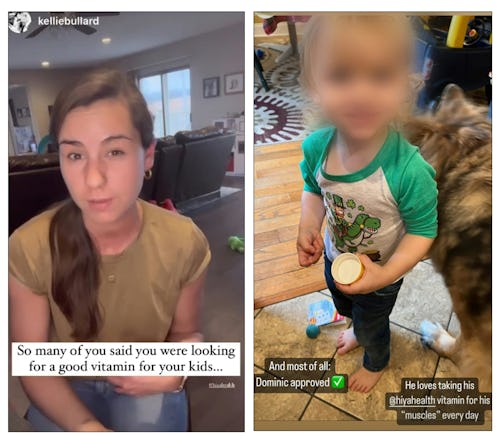
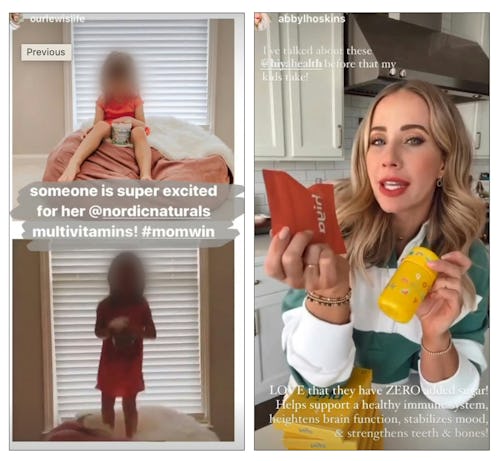
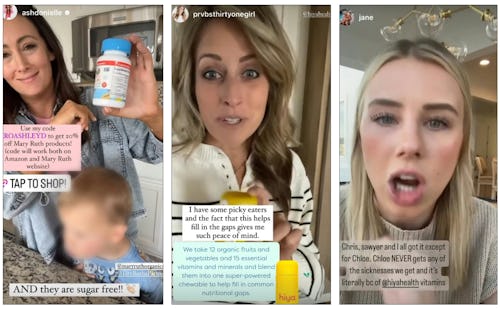
I reached out to some of the companies that were being promoted to me on my social media channels and in the aisles of my neighborhood grocery store, including Hiya, Olly, MaryRuth’s, and a few others. And though many of these companies heartily urge consumers to contact them — particularly if you want to learn more about becoming an “ambassador,” i.e., sell their product on your social channels — none responded to multiple emails asking for insights into how they determine the efficacy, safety, and appropriate pediatric doses of the kids supplements they sell.
If the supplements industry thrives on a lack of regulatory oversight, the influencer marketing industry likewise scrapes by largely without much regulatory interference. It’s a match that has, in part, driven the supplements market we live in and seems made in marketers’ wildest dreams. “The [influencer] industry doesn’t have a cohesive set of rules and ethical guiding principles that it follows, and the Federal Trade Commission (FTC) doesn’t have the resources to ensure that advertising best practices are followed,” explains Emily Hund, Ph.D., a researcher at the Center on Digital Culture and Society at the University of Pennsylvania’s Annenberg School for Communication, and author of The Influencer Industry: The Quest for Authenticity on Social Media. “It falls on us, the user, to try to figure out who is being honest, and what the nature of these deals are, which is just a completely ridiculous premise. We’re really at the mercy of these individuals’ decisions.”
Influencers — and the supplements many of them earn money promoting — are effective and popular because they are filling wide gaps in our social structures.
And parents — infamously and increasingly crushed under a multitude of relentless pressures — are particularly ripe audience. “It’s ideal,” agrees Hund. Midsized social media influencers, which Hund defines as those with anywhere from a few thousand to a few hundred thousand followers, work in a constant sense of precarity, knowing that their livelihood could disappear overnight because of forces beyond their control, like algorithm changes and regulatory shifts. Because of this — and despite the usual claim that they “only work with brands they love” — influencers are highly incentivized to take the deals that they can get, and those deals, Hund says, are typically commission based. However well-intentioned they may be, and however much you feel you can trust them, the reality is fundamentally financial: Influencers need you to click and buy.
Influencers are not ultimately the reason the industry has exploded, however. Hund points out that they are effective and popular because they — and the supplements many of them earn money promoting — are filling wide gaps in our social structures. “I do think that the influencer space is inherently and intimately tied up with the problems that we have in society generally,” Hund says. “Particularly in the parenting space, it is bandaging up wounds that we have in our health care and family systems.”
She draws a direct line between the societal upheaval of the pandemic and the recent “burst” of parenting advice and health advice content. People might not seek out supplements as much if they had strong relationships with a doctor who could help them navigate the complexities of mental health, behavioral issues, and the exhausting Whac-A-Mole of cold-and-flu season. “Getting specialized health care, getting your kid into a developmental psychologist or pediatrician, has been hard for a long time, but it’s increasingly impossible,” she argues.
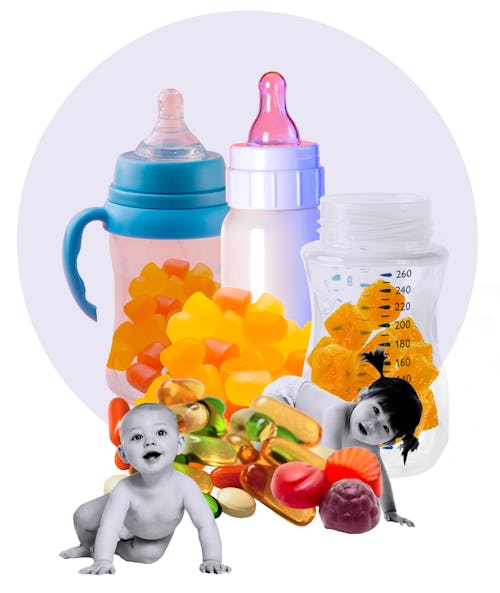
Pediatricians should also be a natural line of defense against misinformation, but they often don’t have the information they need to give clear answers. Supplements are often not well studied, which is, Hund says, yet another structural problem. “We need better information from scientists, from our doctors about supplements and about alternative approaches. So, the bulwark is not as strong as it should be.” In a void of easily accessible care and good information, it’s understandable, she says, that people are turning to social-media influencers for help.
Hopefully, the forthcoming AAP statement will serve to make essential conversations between pediatricians and families about supplement usage more satisfying, nuanced, and informative. The last thing anyone wants is for the relationship between a pediatrician and the families they support to break down over a difference in perspective on alternative treatments. “Let’s not be all snooty about what families are trying to do to help their kid,” Breuner says. “But let’s make sure that what they’re doing is safe, has quality control measures in place, and doesn’t interact with something else that we’re prescribing. And if it’s harmful, then they really need to be encouraged to stop using it.”
0 comments:
Post a Comment